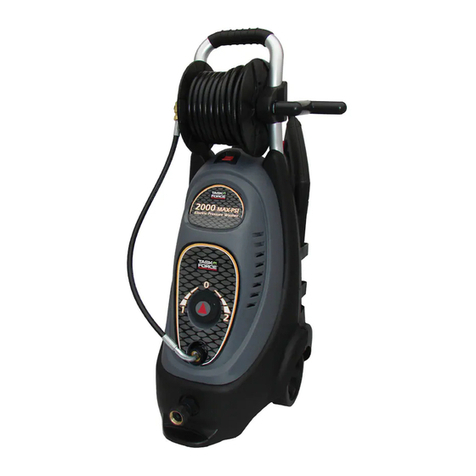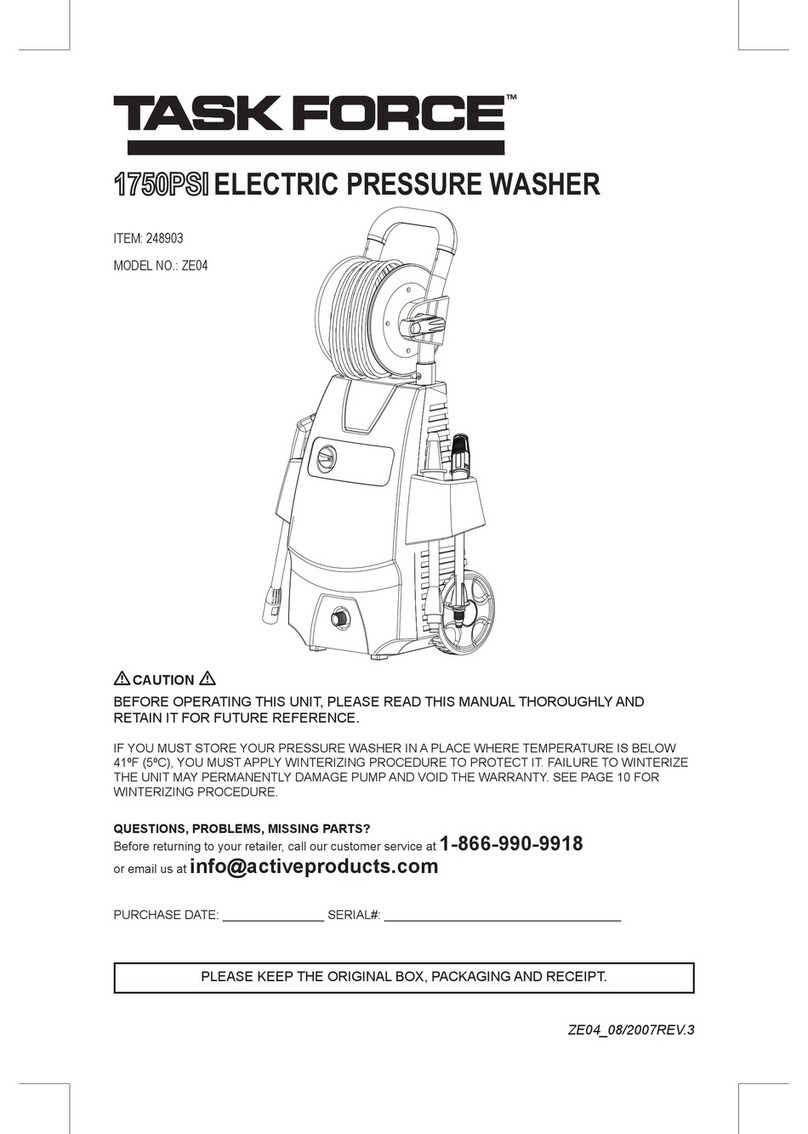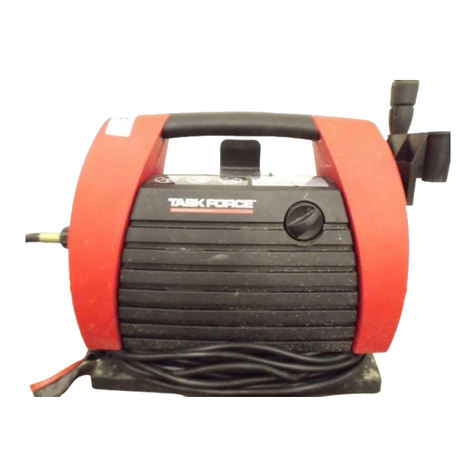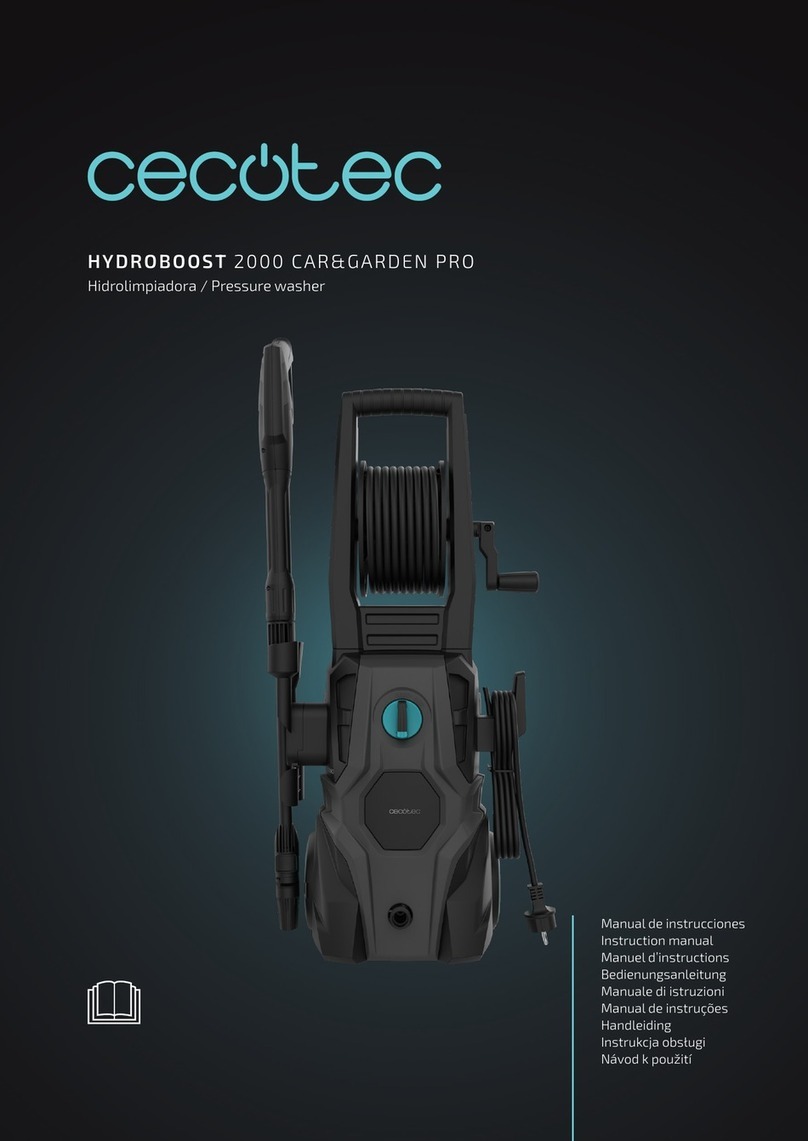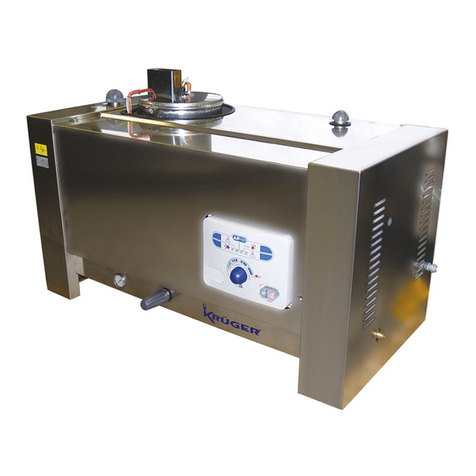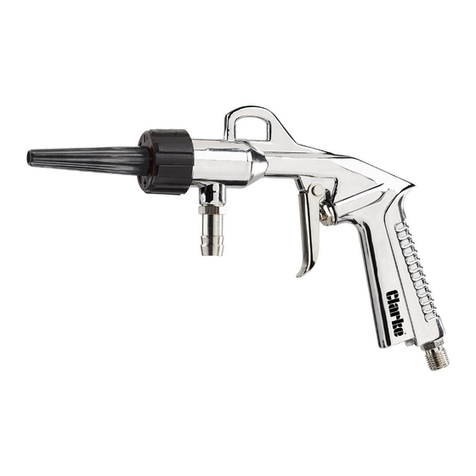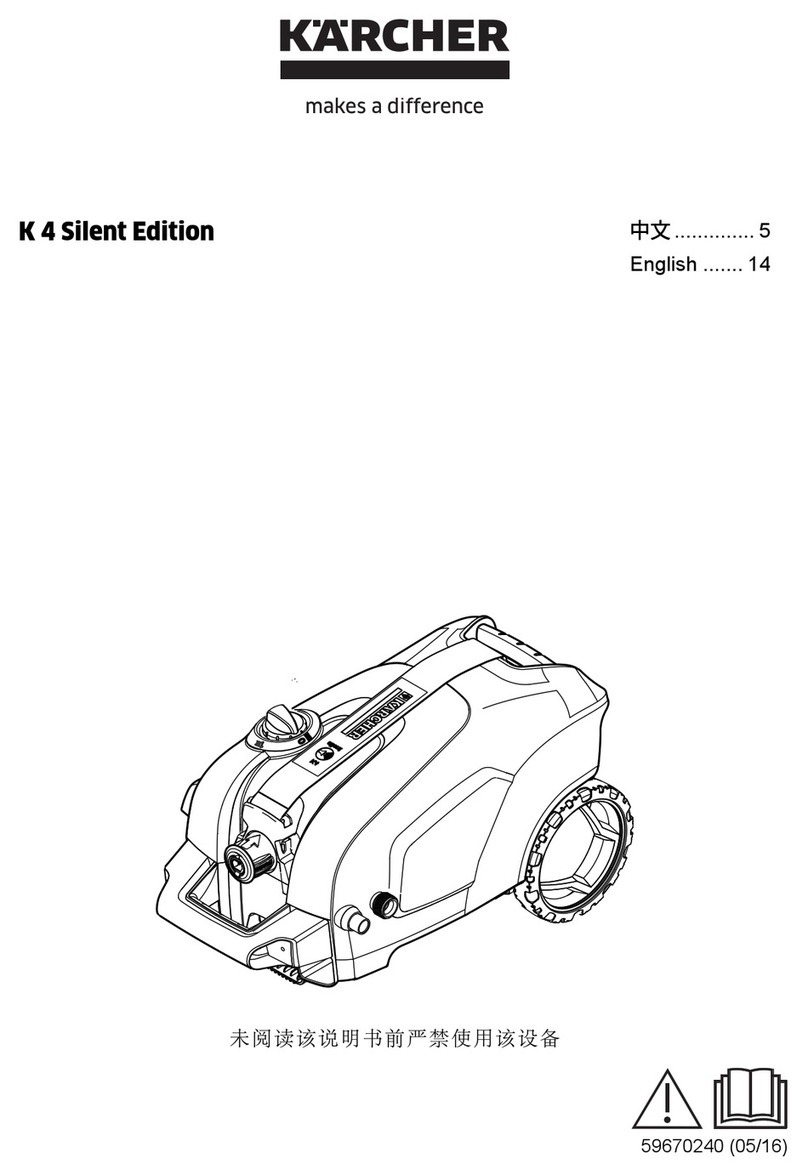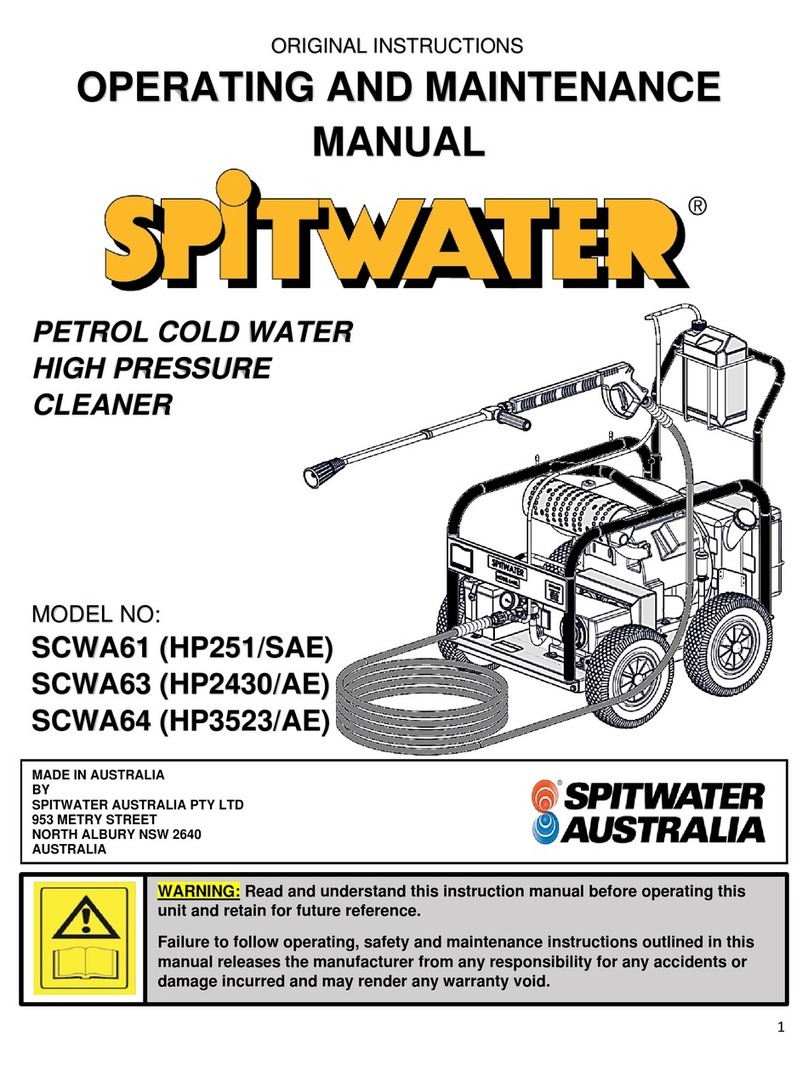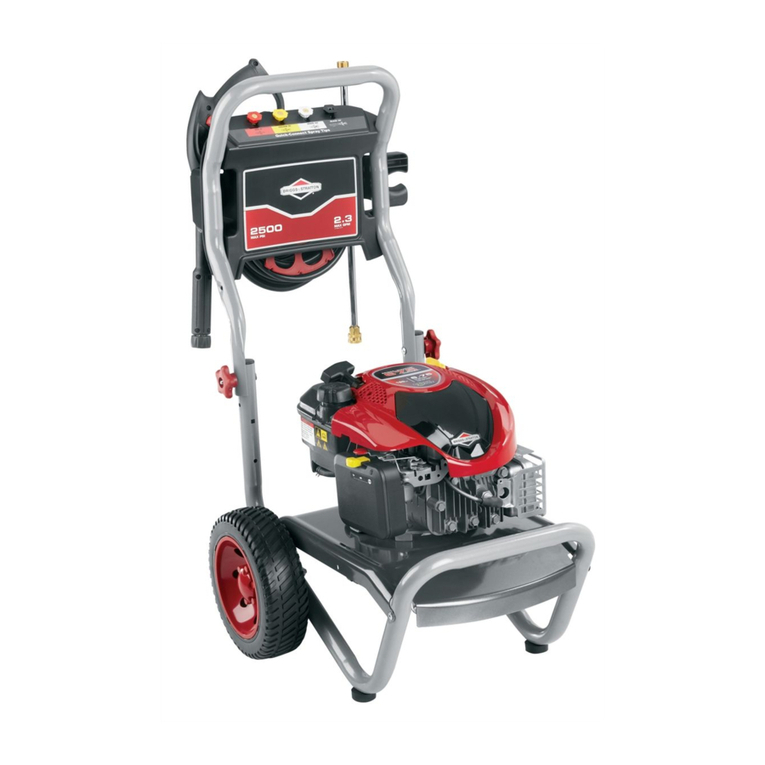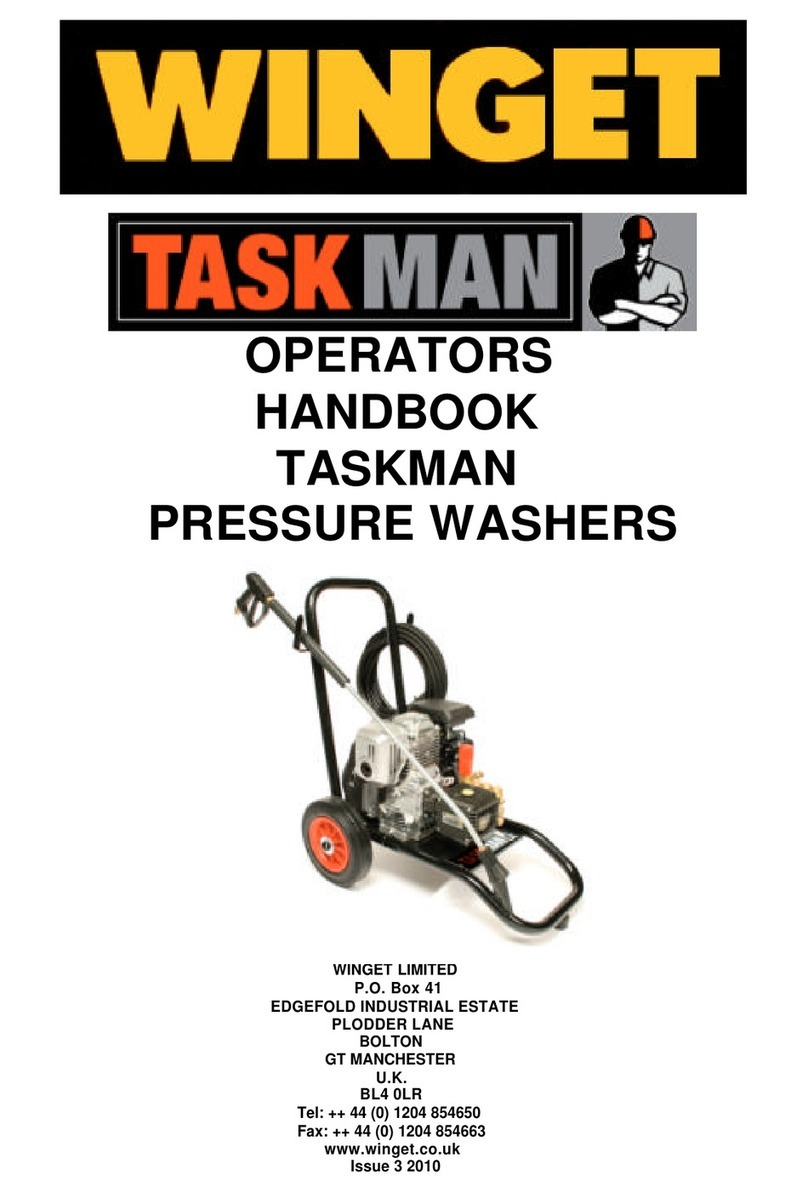Task Force TF2500 User manual

Questions, problems, missing parts? Before returning to your retailer, please contact our
customer service department at 1-866-393-3968.
ITEM / ARTICULO # 0008862
MODEL / MODELO # TF2500
2500PSI GASOLINE
PRESSURE WASHER
Español p. 38
This product is covered by US patents and other international patents.
Copyright. All Rights Reserved.
READ AND SAVE THESE INSTRUCTIONS
EQUIPO GASOLINA DE
LAVADO CON AGUA A
PRESIÓN DE 2500 PSI
LEA Y GUARDE ESTAS INSTRUCCIONES
¿Consultas, problemas, piezas faltantes? Antes de devolver la unidad a la tienda,
contáctese con nuestro Departamento de Servicio al Cliente llamando al 1-866-393-3968.
Este producto está protegido por patentes de los EE. UU. y otras patentes internacionales.
Derecho de autor. Todos los derechos reservados.
Rev.5 2/097102055

2
TABLE OF CONTENTS
PRODUCT SPECIFICATIONS
Specifications ...........................................................................................................................
Safety Information ....................................................................................................................
Carton Contents ....................................................................................................................
Assembly Instructions ............................................................................................................
Operating Instructions ........................................................................................................
Maintenance ........................................................................................................
End of Use and Storage Instructions ....................................................................................
Trouble Shooting Guide .......................................................................................................
Accessories ...................................................................................................................
Repairs ..............................................................................................................................
Warranty ..........................................................................................................................
2
5
16
16
17
25
30
33
36
36
37
Max. pressure *
Water flow rate *
Engine
Pump
High pressure hose
Pressure of inlet water
Inlet water
2500 PSI
2.0 GPM
173cc OHV
Axial cam
25 ft
20 - 100 PSI
Cold tap water
* Ratings determined in accordance with PWMA. Standard PW101.
Engine Specifications ............................................................................................................... 3

3
ENGINE SPECIFICATIONS
F07P1ledoM
VHO,gnilooCriAdecroF,ekortS-4,rednilycelgniSepyT
Max. power(kW/3600rpm) 4.0
Max. torque (N·m/rpm) 9.8/2500
Fuel consumption (g/kW·h) ≤395
Idle speed 1800 ±150 rpm
Bore X Stroke(mm) 70x45
Displacement(cc) 173
1:8
oitaRnoisserpmoC
hsalpSedomgnitacirbuL
tratslioceRedoMgnitratS
)edis.O.T.Pmorf(esiwkcolc-itnAnoitatoR
Valve Clearance Input valve :0.10 ±0.02mm, output valve :0.15 ±0.02mm
”130.0–820.0ROmm8.0~7.0ecnaraelcgulpkrapS
noitingIotengamdezirotsisnarTedoMgnitingI
retlifmaoF,htabliO,yrd-imeSrenaelcriA
Dimension(L×W×H)(mm) 470*390*380
Net weight (kg) 13.7

4
ENGINE SPECIFICATIONS
Serial Number Location
Record the engine serial number in the space below. You will need this serial number when
ordering parts, and when making technical or warranty inquires.
Engine serial number:
Maintenance
Follow the maintenance schedule. Remember that this schedule is based on the assumption that
your machine will be used for its designed purpose. Sustained high-load or high-temperature
operation, or use in unusually wet or dusty conditions, will require more frequent service.
Engine Tune-up
Quick Reference Information
ITEM SPECIFICATION
Spark plug gap 0.028-0.031 in
(0.70-0.80 mm)
Valve clearance IN: 0.10 ±0.02 mm (cold)
EX: 0.15 ±0.02 mm (cold)
Other specications No other adjustments needed
Type SAE 10W-30,API SE or SF, for general use
Engine Oil Capacity 1P61FA, 1P65FA : 0.55L (0.146 US Gal, 0.119 Imp Gal)
1P68FA, 1P70F, 1P70FA : 0.6L (0.16US Gal, 0.13mp Gal)
Type F7RTC or other equivalents.
Spark Plug Gap 0.028 -0.031 in (0.70 -0.80 mm)
Carburetor Idle speed 1800 ±150 rpm
Each use Check engine oil. Check air lter.
First 5 hours Change engine oil.
Maintenance
Subsequent Refer to the maintenance
ENGINE TYPE
SERIAL NUMBER

SAFETY INFORMATION
5
Please read and understand this entire manual before attempting to assemble, operate or install
the product. If you have any questions regarding the product, please contact our customer service
department at 1-866-393-3968.
SAFETY GUIDELINES - DEFINITIONS
This manual contains information that is important for you to know and under -
stand. This information relates to protecting YOUR SAFETY and PREVENTING
EQUIPMENT PROBLEMS . To help you recognize this information, we use the
symbols below. Please read the manual and pay attention to these symbols.
Indicates an immi-
nently hazardous situ-
ation which, if not avoided, will result
in death or serious injury.
Indicates a potentially
hazardous situation
which, if not avoided, may result in
minor or moderate injury.
Indicates a potentially
hazardous situation
which, if not avoided, could result in
death or serious injury.
Used without the
safety alert symbol
indicates a potentially hazardous situ -
ation which, if not avoided, may result
in property damage.
CONSUMER SAFETYINFORMATION
This product may not be equipped with a spark arrest-
ing muffler. If the product is not equipped and will be used
around flammable materials, or on land covered with materials such as
agricultural crops, forest, brush, grass, or other similar items, then an
approved spark arrester must be installed and is legally required in the state
of California. It is a violation of California statutes section 130050 and/or
sections 4442 and 4443 of the California Public Resources Code, unless the
engine is equipped with a spark arrester, as defined in section 4442, and
maintained in effective working order. Spark arresters are also required on
some U.S. Forest Service land and may also be legally required under other
statutes and ordinances.
This product contains chemicals, known to the State of
California to cause cancer, and birth defects or other repro -
ductive harm. Wash hands after handling.
IMPORTANT SAFETYINSTRUCTIONS
Do not operate this unit until you have read and understand
this Operators Manual and the Engine Owners Manual for
Safety, Operation, and Maintenance Instructions.
READ AND SAVE THESE INSTRUCTIONS
RISK OF EXPLOSION OR FIRE
WHAT CAN HAPPEN HOW TO PREVENT IT
• Spilled gasoline and it's vapors
can become ignited from ciga -
rette sparks, electrical arcing,
exhaust gases and hot engine
components such as the muf -
fler.
• Shut off engine and allow it to cool
before adding fuel to the tank.
• Use care in filling tank to avoid spilling
fuel. Move pressure washer away from
fueling area before starting engine.

SAFETY INFORMATION
Please read and understand this entire manual before attempting to assemble, operate or install
the product. If you have any questions regarding the product, please contact our customer service
department at 1-866-393-3968.
RISK TO BREATHING (Asphyxiation)
WHAT CAN HAPPEN HOW TO PREVENT IT
Heat will expand fuel in the
tank which could result in spill-
age and possible fire explosion.
Fill tank to 1/2” (12.7mm) below bottom
of filler neck to provide space for fuel
expansion.
Operating the pressure washer
in an explosive environment
could result in a fire.
Materials placed against or
near the pressure washer can
interfere with its proper ventila-
tion features causing overheat-
ing and possible ignition of the
materials.
Muffler exhaust heat can dam-
age painted surfaces, melt any
material sensitive to heat (such
as siding, plastic, rubber, vinyl,
or the pressure hose itself), and
damage live plants
Improperly stored fuel could
lead to accidental ignition. Fuel
improperly secured could get
into the hands of children or
other unqualified persons.
Use of acids, toxic or corrosive
chemicals, poisons, insecticides,
or any kind of flammable solvent
with this product could result in
serious injury or death.
Operate and fuel equipment in well-
ventilated areas free from obstructions.
Equip areas with fire extinguishers suit-
able for gasoline fires.
Never operate pressure washer in an
area containing dry brush or weeds.
Always keep pressure washer a mini-
mum of 4’ (1.2m) away from surfaces
(such as houses, automobiles, or live
plants) that could be damaged from
muffler exhaust heat.
Store fuel in an OSHA-approved
container, in a secure location away
from the work area.
Do not spray flammable liquids.
Breathing exhaust fumes will
cause serious injury or death!
Engine exhaust contains car-
bon monoxide, an odorless and
deadly gas.
Some cleaning fluids contain
substances which could cause
injury to skin, eyes, or lungs.
Operate Pressure washer in a well-
ventilated area. Avoid enclosed areas
such as garages, basements, etc.
Never operate unit in a location occu-
pied by humans or animals.
Use only cleaning fluids specifically
recommended for high-pressure wash-
ers. Follow manunfacturers
recommendations. Do not use chlorine
bleach or any other corrosive compound.
6

RISK OF FLUID INJECTION AND LACERATION
WHAT CAN HAPPEN HOW TO PREVENT IT
RISK OF INJURY FROM SPRAY
WHAT CAN HAPPEN HOW TO PREVENT IT
SAFETY INFORMATION
Please read and understand this entire manual before attempting to assemble, operate or install
the product. If you have any questions regarding the product, please contact our customer service
department at 1-866-393-3968.
Your pressure washer operates
at fluid pressures and veloci-
ties high enough to penetrate
human and animal flesh, which
could result in amputation or
other serious injury. Leaks
caused by loose fittings or
worn or damaged hoses can
fesult in injection injuries. DO
NOT TREAT FLUID INJECTION
AS A SIMPLE CUT! See a phy-
sician immediately!
Inspect the high-pressure hose regular-
ly. Replace the hose immediately if it is
damaged, worn, has melted from con-
tacting the engine, or shows signs of
cracks, bubbles, pinholes, or other
leakage. Never grasp a high-pressure
hose that is leaking or damaged.
Never touch, grasp, or attempt to cover
a pinhole or similar water leak on the
high pressure hose. The stream of
water IS under high pressure and WILL
penetrate skin.
Never place hands in front of nozzle.
Direct spray away from self and others.
Make sure hose and fittings are tight-
ened and in good condition. Never
hold onto the hose or fittings during
operation.
Do not allow the hose to contact muffler.
Never attach or remove wand or hose
fittings while system is pressurized.
Injuries can result if system
pressure is not reduced before
attempting maintenance or
disassembly.
To relieve system pressure, shut off
engine, turn off water supply and pull
gun trigger until water stops flowing.
Use only hoses and accessories rated
for pressure higher than your pressure
washer’s psi.
High-velocity fuild spray can
cause objects to break, propel-
ling particles at high speed.
Light or unsecured objects can
become hazardous projectiles.
Always wear ANSI-approved Z87.1
safety glasses. Wear protective clothing
to protect against accidental spraying.
Never point wand at or spray people or
animals.
Always secure trigger lock when wand
is not in service to prevent accidental
operation.
Never permanently secure trigger in
pull-back (open) position.
7

SAFETY INFORMATION
Please read and understand this entire manual before attempting to assemble, operate or install
the product. If you have any questions regarding the product, please contact our customer service
department at 1-866-393-3968.
RISK OF UNSAFE OPERATION
WHAT CAN HAPPEN HOW TO PREVENT IT
Unsafe operation of your press-
ure washer could lead to seri-
ous injury or death to you or
others.
Do not use chlorine bleach or any other
corrosive compound.
Become familiar with the operation and
controls of the pressure washer.
Keep operating area clear of all
persons, pets, and obstacles.
Do not operate the product when
fatigued or under the influence of alco-
hol or drugs. Stay alert at all times.
Never defeat the safety features of this
product.
Do not operate machine with missing,
broken, or unauthorized parts.
Never leave the wand unattended
while the unit is running.
If proper starting procedure is
not followed, engine can kick-
back causing serious hand and
arm injury.
The spraygun/wand is a power-
ful cleaning tool that could look
like a toy to a child.
Reactive force of spray will
cause gun/wand to kick-back,
and could cause the operator to
slip or fall, or misdirect the
spray. Improper control of gun/
wand can result in injuries to
self and others.
If engine does not start after two pulls,
squeeze trigger of gun to relieve pump
pressure. Pull started cord slowly until
resistance is felt. Then pull cord rapidly
to avoid kick-back and prevent hand or
arm injury.
Keep children away from the pressure
washer at all times.
Do not overreach or stand on an
unstable support.
Do not use pressure washer while
standing on a ladder.
Grip gun/wand firmly with both hands.
Expect the gun to kick-back when
triggered.
8

SAFETY INFORMATION
Please read and understand this entire manual before attempting to assemble, operate or install
the product. If you have any questions regarding the product, please contact our customer service
department at 1-866-393-3968.
RISK OF INJURY OR PROPERTY DAMAGE WHEN
TRANSPORTING OR STORING
WHAT CAN HAPPEN HOW TO PREVENT IT
RISK OF BURSTING
WHAT CAN HAPPEN HOW TO PREVENT IT
RISK OF HOT SURFACES
WHAT CAN HAPPEN HOW TO PREVENT IT
Fuel or oil can leak or spill and
could result in fire or breathing
hazard. Serious injury or death
can result. Fuel or oil leaks will
damage carpet, paint, or other
surfaces in vehicles or trailers.
If pressure washer is equipped with
a fuel shut-off valve, turn the valve to
the OFF position before transporting to
avoid fuel leaks. If pressure washer
is not equipped with a fuel shut-off
valve, drain the fuel from tank before
transporting. Only transport fuel in an
OSHA-approved container. Always
place pressure washer on a protective
mat when transporting to protect
against damage to vehicle from leaks.
Remove pressure washer from vehicle
immediately upon arrival at destination.
Over inflation of tires could
result in serious injury and
property damage.
Use a tire pressure gauge to check the
tire pressure before each use and while
inflating tires; see the tire sidewall for the
correct tire pressure.
NOTE: Air tanks, compressors, and
similar equipment used to inflate tires
can fill small tires similar to these very
rapidly. Adjust pressure regulator on air
supply to no more than the rating of the
tire pressure. Add air in small increments
and frequently use the tire gauge to
prevent over inflation.
High Velocity fuid spray directed
at pneumatic sidewalls
(such as found on automobiles,
trailers, and the like) could dam-
age the sidewall resulting in
serious injury.
On pressure washer rated above 1600
psi (110 Bar) use the widest fan spray
(40º nozzle) and keep the spray a mini-
mum of 8” (20cm) from the pneumatic
tire sidewall. Do not aim spray directly
at the joint between the tire and rim.
Contact with hot surfaces, such
as engine exhaust components,
could result in serious burn.
During operation, touch only the control
surfaces of the pressure washer.
Keep children away from the pressure
washer at all times. They may not be
able to recognize the hazards of this
product.
9

SAFETY INFORMATION
Please read and understand this entire manual before attempting to assemble, operate or install
the product. If you have any questions regarding the product, please contact our customer service
department at 1-866-393-3968.
RISK OF CHEMICAL BURN
WHAT CAN HAPPEN HOW TO PREVENT IT
• Use of acids, toxic or corrosive
chemicals, poisons, insecti-
cides, or any kind of flammable
solvent with this product could
result in serious injury or death.
• Do not use acids, gasoline, kerosene,
or any other flammable materials in this
product. Use only household deter-
gents, cleaners and degreasers recom-
mended for use in pressure washers.
• Wear protective clothing to protect
eyes and skin from contact with
sprayed materials.
RISK OF LACIRTCELE SHOCK
WHAT CAN HAPPEN HOW TO PREVENT IT
• Spray directed at electrical out-
lets or switches, or ob jects con-
nected to an electrical circuit,
could result in a fatal electrical
shock.
• Unplug any electrically operated prod-
uct before attempting to clean it. Direct
spray away from electric outlets and
switches.
RISK OF INJURY FROM LIFTING
WHAT CAN HAPPEN HOW TO PREVENT IT
• Serious injury can result from
attempting to lift too heavy an
object.
• The pressure washer is too heavy to be
lifted by one person. Obtain assistance
from others before lifting.
READ AND SAVE THESE INSTRUCTIONS
10

The engine exhaust from this product contains
chemicals known to the State of California to cause
cancer, birth defects, or other re
p
roductive harm.
The safety alert symbol ()is used to identify safety information about hazards that can
result in personal injury.
A signal word (WARNING,DANGER, or CAUTION) is used with the alert symbol to indicate the
likelihood and the potential severity of injury. In addition, a hazard symbol may be used to
represent the type of hazard.
WARNING indicates a hazard which, if not avoided, will result in death or serious
injury.
DANGER indicates a hazard which, if not avoided, could result in death or serious
injury.
CAUTION indicates a hazard which, if not avoided, might result in minor or moderate
injury.
When used without the alert symbol, indicates a situation that could result in damage to
the engine.
CAUTION:You should carefully read and understand the operating instructions for the
TF2500 Pressure Washer.
BEFORE OPERATING ENGINE
Read entire Operating &Maintenance Instructions AND the
instructions for the equipment this engine powers.
Failure to follow instructions could result in serious injury
or death.
THE OPERATING &MAINTENANCE INSTRUCTIONS CONTAIN
SAFETY INFORMATION TO
Make you aware of hazards associated with engines
Inform you of the risk of injury associated with those hazards,and
Tell
y
ou how to avoid or reduce the risk of in
j
ur
y
.
THE INTERNATIONAL SYMBOLS USED ON
THE ENGINE OR IN THIS MANUAL INCLUDE:
WARNING
SAFETY INFORMATION
11

SAFETY INFORMATION
12
HAZARD SYMBOLS AND MEANINGS

SAFETY INFORMATION
13
IMPORTANT SAFETY INFORMATION
Most accidents with engines can be prevented if you follow all instructions in this manual
and on the engine. Some of the most common hazards are discussed below, along with the
best way to protect yourself and others.
Owner Responsibilities
The engines are designed to give safe and dependable service if operated according to
instructions. Read and understand this owner’s manual before operating the engine. Failure
to do so could result in personal injury or equipment damage.
Know how to stop the engine quickly, and understand the operation of all controls. Never
permit anyone to operate the engine without proper instructions.
Do not allow children to operate the engine. Keep children and pets away from the area of
operation.
Gasoline and its vapors are extremely flammable and
explosive.
Fire or explosion can cause severe burns or death.
WHEN ADDING FUEL
Turn engine OFF and let engine cool at least 2 minutes before removing gas cap.
Fill fuel tank outdoors or in well-ventilated area.
Do not overll fuel tank. Fill tank to approximately 1-1/2 inches below top of neck to
allow for fuel expansion.
Keep gasoline away from sparks, open ames, pilot lights, heat, and other ignition
sources.
Check fuel lines, tank, cap, and ttings frequently for cracks or leaks. Replace if
necessary.
WHEN STARTING ENGINE
Make sure spark plug, muer, fuel cap and air cleaner are in place.
Do not crank engine with spark plug removed.
If fuel spills, wait until it evaporates before starting engine.
If engine oods, set choke to OPEN position, place ON/OFF switch in
ON position and crank until engine starts.
WHEN OPERATING EQUIPMENT
Do not tip engine or equipment at angle which causes gasoline to spill.
Do not choke carburetor to stop engine.
WHEN TRANSPORTING EQUIPMENT
Transport with fuel tank EMPTYor with fuel shut-o valve OFF.
WHEN STORING GASOLINE OR EQUIPMENT WITH FUEL IN TANK
Store away from furnaces, stoves, water heaters or other appliances that have pilot
light or other ignition source because they can ignite gasoline vapors.
WARNING

SAFETY INFORMATION
14
Starting engine creates sparking.
Sparking can ignite nearby flammable gases.
Explosion and fire could result.
If there is natural or gas leakage in area, do not start engine.
Do not use pressurized starting uids because vapors are ammable.
Rapid retraction of starter cord (kickback) will pull hand and
arm toward engine faster than you can let go.
Broken bones, fractures, bruises or sprains could result.
When starting engine, pull cord slowly until resistance is felt, then pull rapidly.
Remove all external equipment/engine loads before starting engine.
Direct coupled equipment components such as, but not limited to, blades, impellors,
pulleys, sprockets, etc., must be securely attached.
Engines give off carbon monoxide, an odorless, colorless,
poison gas.
Broken bones, fractures, bruises or sprains could result.
Start and run engine outdoors.
Do not start or run engine enclosed area, even if doors or windows are open.
Rotating parts can contact or entangle hands, feet, hair, clothing
,
or accessories.
Traumatic amputation or severe laceration can result.
Operate equipment with guards in place.
Keep hands and feet away from rotating parts.
Tie up long hair and remove jewelry.
Do not wear loose-tting clothing, dangling drawstrings or items that could become
caught.
WARNING
WARNING
WARNING
WARNING

SAFETY INFORMATION
15
Running engines produce heat. Engine parts,
especially muffler, become extremely hot.
Severe thermal burns can occur on contact.
Combustible debris, such as leaves, grass, brush,
etc. can catch fire.
Allow muer, engine cylinder and ns to cool before touching.
Remove accumulated combustibles from muer area and cylinder area.
Unintentional sparking can result in fire or electric
shock.
Unintentional start-up can result in entanglement,
traumatic amputation, or laceration.
BEFORE PERFORMING ADJUSTMENTS OR REPAIRS
Disconnect spark plug wire and keep it away from spark plug.
Disconnect battery at negative terminal (only engines with electric start).
WHEN TESTING FOR SPARK
Use approved spark plug tester.
Do not check for spark with spark plug removed.
WARNING
WARNING

CARTON CONTENTS
1. Locate and remove all loose
parts from the carton.
2. Cut four cornersof the carton
from top to bottom and lay the
panels flat.
3. Place handle onto
frame , depress the
snap buttons, and
slide the handle
assembly onto the
frame until snap
buttons snap into
place.
Risk of personal
injury. Avoid plac-
ing hands between handle and
frame when assembling to prevent
pinching.
4. Connect wand to gun.Tighten
securely.
5. Attach high
pressure hose to
gun. Tighten
securely.
Engine Frame
and Wheel
Assembly
High Pressure
Hose
Spray Gun
Handle
Chemical
Hose
Bagged Parts
Nozzle
Cleaning
Tool
Engine
Manual
Operation
Manual
Multi-Adjustable
Spray Wand
ASSEMBLY INSTRUCTIONS
16
NOTE: Photographs and line drawings used in this manual are for reference only
and do not represent a specific model.

OPERATING INSTRUCTIONS
NOTE: The pump on this unit is
maintenance free and requires no oil.
If there is a problem with the pump
contact an Authorized Service Center.
Compare the illustrations with your unit to familiarize yourself with the location of
various controls and adjustments. Save this manual for future reference.
High
Pressure
Hose
Spray
Gun
High Pressure Pump
Engine
Multi-Adjustable
Spray Wand
BASIC ELEMENTS OF A
PRESSURE WASHER
High Pressure Pump: Increases the
pressure of the water supply.
Engine: Drives the high pressure
pump.
High Pressure Hose: Carries the pres-
surized water from the pump to the
gun and spray wand.
Spray Gun:Connects with spray wand
to control water flow rate, direction,
and pressure.
Multi-Adjustable Spray Wand: Allows
the user to use high or low pressure and
adjusts from a pencil stream (0°) to a wide
angle fan spray (40°). See How To Use Wand
instructions in this section.
Chemical Hose (not shown): Feeds
cleaning agents into the pump to mix
with the water. See
How To Apply
Chemicals/Cleaning Solvents
instruc-
tions in this section.
17
Engine shipped without oil. Before starting engine,
fill with oil provided. If you start the engine
without oil, the engine will be damaged beyond
repair and will not be covered under warranty.

BASIC ELEMENTS OF AN
ENGINE
18
1P68FA, 1P70F, 1P70FA
1P61FA, 1P65FA
FUEL TANK
FUEL TANK CAP
STARTER GRIP
OIL FILLERCAP/
DISPTICK
A
IR CLEANER
MUFFLER
FINGER GUARD
CARBURETOR
FUEL TANK CAP
FUEL TANK
AIR CLEANER
SPARK PLUG
MUFFLER
FINGER GUARD
STARTER GRIP

PRESSURE WASHER OPERATING
FEATURES
Pressure Adjustments
The pressure setting is preset at the fac-
tory to achieve optimum pressure and
cleaning. If you need to lower the pres-
sure, it can be accomplished by these
methods.
1. Back away from the surface to
be cleaned. The further away you
are, the less the pressure will be on
the surface to be cleaned.
2. Rotate the nozzle at the end of
the multi-adjustable spray wand
to widen the fan spray.
The wider fan spray will minimize
the pressure on the surface to
be cleaned.
PRESSURE WASHER
TERMINOLOGY
psi: Pounds per Square Inch. The unit
of measure for water pressure. Also
used for air pressure, hydraulic pres-
sure, etc.
GPM: Gallons Per Minute. The unit of
measure for the flow rate of water.
CU: Cleaning Units. GPM multiplied
by psi. GPM x psi = CU
Bypass Mode: Allows water to
re-circulate within pump when the gun
trigger is not pulled.
Allowing the unit to
run for more than
two minutes without the gun trigger
pulled could cause overheating and
damage to the pump.
Thermal Relief Valve (not shown)
When the temperature inside the
pump rises too high the valve will
open and release a gush of water in
an effort to lower the temperature
inside the pump. The valve will then
close.
Chemical Injection System: Mixes
cleaners or cleaning solvents with
the water to improve cleaning
effectiveness.
Water Supply: All pressure washers
must have a source of water. The min-
imum requirements for a water supply
are 20 psi and 5 gallons per minute.
19

Risk of fluid
injection. Do not
direct discharge stream toward
persons, unprotected skin, eyes or
any pets or animals. Serious injury
will occur.
For high pressure operation, pull back
the nozzle of the multi-adjustable
spray wand as shown.
The nozzle at the end of the multi-
adjustable spray wand can be rotated
to change the high pressure spray
pattern from a 0º pencil stream to a
40º fan spray, as shown. Markings
have been placed on the nozzle to
help you select the spray pattern.
For low pressure operation, extend
the nozzle of the multi-adjustable
spray wand as shown.
The powerful
spray from your
pressure washer is capable of
causing damage to surfaces such
as wood, glass, automobile paint,
auto striping and trim, and delicate
objects such as flowers and shrubs.
Before spraying, check the item to
be cleaned to assure yourself that it
is strong enough to resist damage
from the force of the spray.
HOW TO USE SPRAY WAND
Your pressure washer is equipped
with a multi-adjustable spray wand
with both high and low pressure
settings. The high pressure setting
is for cleaning and rinsing, the low
pressure setting is for applying
chemicals or cleaning solutions to
surfaces.
How to Apply Chemicals/Cleaning
Solvents
Applying chemicals or cleaning sol-
vents is a low pressure operation.
NOTE: Use only soaps and chemicals
designed for pressure washer use. Do
not use bleach.
To Apply chemicals:
1. Press chemical Barbed
Fitting
hose onto
barbed fitting
located near high
pressure hose
connection of
pump as shown.
2. Place other end of chemical hose
with filter on it into container hold-
ing chemical/cleaning solution.
NOTE: For every 7 gallons of
water pumped 1 gallon of chemi-
cal/cleaning solution will be used.
20
3. Set multi-adjustable nozzle to
low pressure setting. See How
To Use Wand paragraph in this
section.
4. After use of chemicals,place
chemical hose into container of
clean water and draw clean water
through chemical injection
system to rinse system
thoroughly. If chemicals remain
in the pump it could be
damaged. Pumps damaged
due to chemicals will not be
covered under warranty.
Table of contents
Languages:
Other Task Force Pressure Washer manuals
